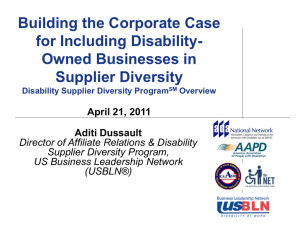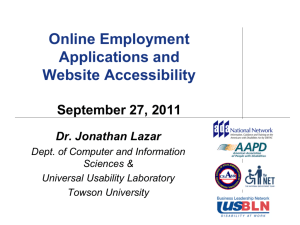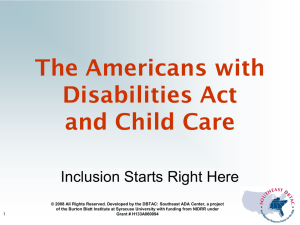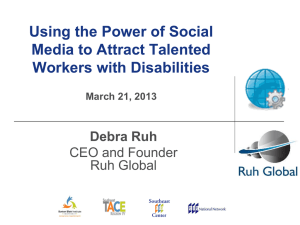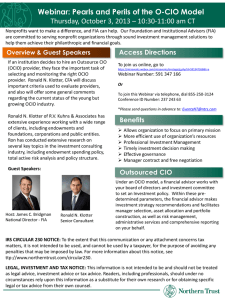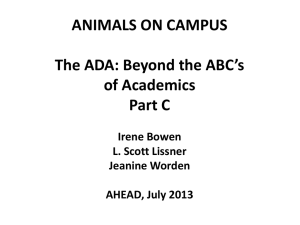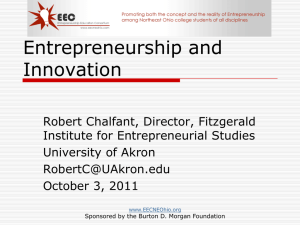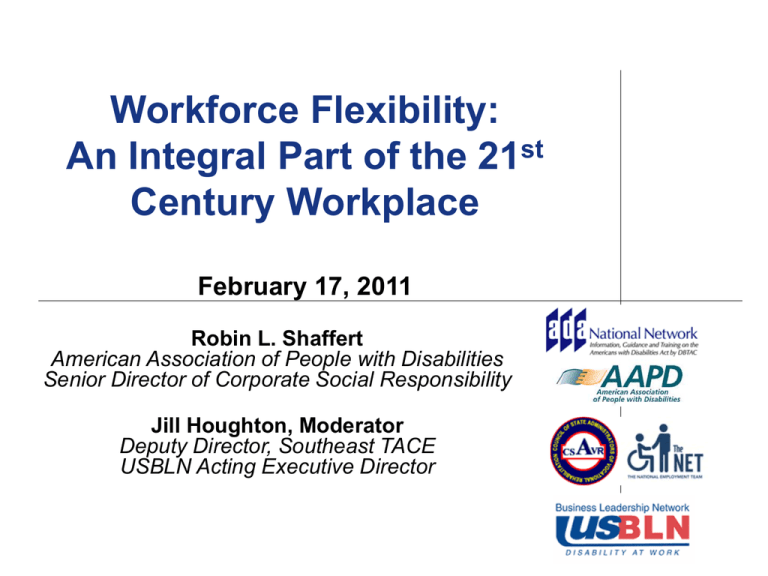
Workforce Flexibility:
An Integral Part of the 21st
Century Workplace
February 17, 2011
Robin L. Shaffert
American Association of People with Disabilities
Senior Director of Corporate Social Responsibility
Jill Houghton, Moderator
Deputy Director, Southeast TACE
USBLN Acting Executive Director
2
ADA National Network Centers
1-800-949-4232 [voice/tty]
adata.org
Webinar Series for Business
Hosted by: Southeast ADA Center and SoutheastTACE
Projects of Burton Blatt Institute at Syracuse University
Funded by NIDRR Grant # H133A060094. © 2011 All Rights Reserved
3
Workforce Flexibility:
An Integral Part of the 21st
Century Workplace
Flexibility is Important for Everyone –
Especially Workers with Disabilities
Webinar Series for Business
Hosted by: Southeast ADA Center and SoutheastTACE
Projects of Burton Blatt Institute at Syracuse University
Funded by NIDRR Grant # H133A060094. © 2011 All Rights Reserved
4
President Barack Obama Quote
Workplace flexibility isn’t just a women’s
issue. It’s an issue that affects the well-being
of our families and the success of our
businesses. It affects the strength of our
economy – whether we’ll create the
workplaces and jobs of the future that we
need to compete in today’s global economy.
--President Barack Obama
Webinar Series for Business
Hosted by: Southeast ADA Center and SoutheastTACE
Projects of Burton Blatt Institute at Syracuse University
Funded by NIDRR Grant # H133A060094. © 2011 All Rights Reserved
National Dialogue on
Disability Employment
WF has entered the National Dialogue on Disability
Employment
Women’s Bureau and the Office of Disability Employment
Policy: Memo of Understanding
“The purpose of this Memorandum of Agreement (MOA) is to
establish an understanding between the Women’s Bureau
(WB) and the Office of Disability Employment Policy (ODEP) to
expand and promote the use of flexible workplace strategies.”
Office of Federal Contractor Compliance Programs: Request
for Comments and Advanced Notice of Proposed Rule
Making on Affirmative Action and Nondiscrimination
Obligations of Contractors and Subcontractors
“To what extent does workplace flexibility, including flexibility in
work schedules, as well as job-protected leave, impact
recruitment and retention of individuals with disabilities?”
Webinar Series for Business
Hosted by: Southeast ADA Center and SoutheastTACE
Projects of Burton Blatt Institute at Syracuse University
Funded by NIDRR Grant # H133A060094. © 2011 All Rights Reserved
5
Reality #1: Shifting Demographics
Women are almost 50% of the workforce
Dual earner incomes are the norm
Older workers need to work longer to save for retirement
Men and women want and need to share caregiving
responsibilities for children and parents, including those with
disabilities
There are many more single-parent families
While a persistently high percentage of people with
disabilities remain unemployed or underemployed, many
people with disabilities and chronic health conditions are in
the workforce and more are ready, willing, and able to work
Webinar Series for Business
Hosted by: Southeast ADA Center and SoutheastTACE
Projects of Burton Blatt Institute at Syracuse University
Funded by NIDRR Grant # H133A060094. © 2011 All Rights Reserved
6
Reality #2: Resulting Mismatch
Rigid or unpredictable schedules leave workers without
control needed to deal with day-to-day issues or
emergencies
Traditional work calendars offer little time off for health-
related problems, family concerns, or caretaking
responsibilities
Linear career paths are incompatible with modern life
courses
Employees with disabilities may need flexibility to
address medical, transportation, or other disabilityrelated needs
Webinar Series for Business
Hosted by: Southeast ADA Center and SoutheastTACE
Projects of Burton Blatt Institute at Syracuse University
Funded by NIDRR Grant # H133A060094. © 2011 All Rights Reserved
7
Workforce Flexibility
An Additional Tool to Promote Disability Employment
Under the ADA, employees with disabilities are entitled to
reasonable accommodations that may include part-time
schedules, modifications to standard shifts, and
telecommuting
Under the FMLA, individuals with serious health conditions
and employees caring for immediate family members with
serious health conditions are entitled to 12 weeks a year of
unpaid leave
Webinar Series for Business
Hosted by: Southeast ADA Center and SoutheastTACE
Projects of Burton Blatt Institute at Syracuse University
Funded by NIDRR Grant # H133A060094. © 2011 All Rights Reserved
8
Workforce Flexibility (cont.)
An Additional Tool to Promote Disability Employment
“Workplace flexibility” is a framework and additional set of
tools that employers can use to help all employees achieve
success in the workplace and balance in their lives for a
range of reasons, including employees with disabilities
Webinar Series for Business
Hosted by: Southeast ADA Center and SoutheastTACE
Projects of Burton Blatt Institute at Syracuse University
Funded by NIDRR Grant # H133A060094. © 2011 All Rights Reserved
9
Key Findings: The Business
Case
Employees with access to FWAs tend to be more
satisfied, committed, and engaged with their jobs.
Studies have shown that this leads to increased
innovation, quality, productivity, and market share
Research by the Corporate Leadership Council
concluded that every 10% improvement in commitment
can increase an employee’s level of discretionary effort
by 6% and performance by 2%; highly committed
employees perform at a higher level than non-committed
employees
Webinar Series for Business
Hosted by: Southeast ADA Center and SoutheastTACE
Projects of Burton Blatt Institute at Syracuse University
Funded by NIDRR Grant # H133A060094. © 2011 All Rights Reserved
10
Key Findings: The Business
Case
(cont.)
Providing FWAs and time off to take care of personal
and family needs can also help limit unscheduled
absences
Studies show that employees using FWAs report
less work-life stress and, as a result, have less
unscheduled absences and increased productivity
Webinar Series for Business
Hosted by: Southeast ADA Center and SoutheastTACE
Projects of Burton Blatt Institute at Syracuse University
Funded by NIDRR Grant # H133A060094. © 2011 All Rights Reserved
11
3 “Buckets” of Workplace Flexibility
Work
Time Off
Flexible
Flexible
Work Arrangements
Arrangements
Including:
Career Flexibility
Including:
Including:
Including:
Flex Schedules (e.g., flexible
start and end times; compressed
workweeks)
Predictable (e.g.,advance notice) Schedules
Flex
flexible
Short-Term
Time Off job sharing)
Exit
Schedules
Reduced(e.g.,
Hours
(e.g., phased
retirement;
start and end times;
Place of Work (e.g., telework; “hoteling”)
compressed workweeks)
Time Off
Including:
Predictable
Schedules
advance
Short-Term
Time Off
(e.g.,
notice)
Episodic Time Off
Maintenance
Extended Time Off
Reentry (on ramps)
Episodic Time Off
Reduced
Hours (e.g.,
Extended
Time Off
retirement;
job
phased
Career
Flexibility
sharing)
Including:
Exit
Maintenance
telework;
“hoteling”)
Reentry (on ramps)
Place of Work (e.g.,
Webinar Series for Business
Hosted by: Southeast ADA Center and SoutheastTACE
Projects of Burton Blatt Institute at Syracuse University
Funded by NIDRR Grant # H133A060094. © 2011 All Rights Reserved
12
For companies that offer them,
FWAs…
Improve retention & recruitment
Foster greater employee satisfaction, commitment, and
engagement
Are correlated to increased productivity and revenue
generation, as well as positive impacts on cycle time and
client service
Webinar Series for Business
Hosted by: Southeast ADA Center and SoutheastTACE
Projects of Burton Blatt Institute at Syracuse University
Funded by NIDRR Grant # H133A060094. © 2011 All Rights Reserved
13
Flexibility & Hourly Workers
Critical management tool to meet core business goals
and improve work-life fit by providing predictability and
stability
Flexibility works as well, or better, for hourly workers as
for professionals
Implementation as management tool rather than on an
individual basis increases return on investment
Key Elements: (i) providing a variety of flexible work
options that are compatible with hourly jobs, (ii) enabling
workers to adjust work hours and access time off when
needed, (iii) creating a supportive work culture, and (iv)
engaging work teams in designing and managing flexible
work
Webinar Series for Business
Hosted by: Southeast ADA Center and SoutheastTACE
Projects of Burton Blatt Institute at Syracuse University
Funded by NIDRR Grant # H133A060094. © 2011 All Rights Reserved
14
Flexibility & Hourly Workers (cont.)
Opportunity to review and modernize policies concerning
mandatory overtime, leave, and absenteeism
Many workers with disabilities are hourly workers
Webinar Series for Business
Hosted by: Southeast ADA Center and SoutheastTACE
Projects of Burton Blatt Institute at Syracuse University
Funded by NIDRR Grant # H133A060094. © 2011 All Rights Reserved
15
The Collaborative on FWAs
The following groups representing diverse
constituencies are working together on specific
ideas to increase access to FWAs
AARP
American Association of People with Disabilities
Corporate Voices for Working Families
Family Values at Work
Legal Momentum
National Military Family Association
National Partnership for Women and Families
New America Foundation
Society for Human Resource Management
Workplace Flexibility 2010
WorldatWork
Webinar Series for Business
Hosted by: Southeast ADA Center and SoutheastTACE
Projects of Burton Blatt Institute at Syracuse University
Funded by NIDRR Grant # H133A060094. © 2011 All Rights Reserved
16
17
Open Discussion
&
Questions
Webinar Series for Business
Hosted by: Southeast ADA Center and SoutheastTACE
Projects of Burton Blatt Institute at Syracuse University
Funded by NIDRR Grant # H133A060094. © 2011 All Rights Reserved
*
18
THANK YOU!
Webinar Series for Business
Hosted by: Southeast ADA Center and SoutheastTACE
Projects of Burton Blatt Institute at Syracuse University
Funded by NIDRR Grant # H133A060094. © 2011 All Rights Reserved
19
Contact Information
Please Feel Free to Reach Out to Us
Jill Houghton
Deputy Director
Southeast TACE
Acting Executive Director
USBLN
(954) 461-4726 [voice]
Jilldh@bellsouth.net
Robin L. Shaffert
Senior Director of Corporate
*
Social Responsibility
American Association of People
with Disabilities (AAPD)
RShaffert@aapd.com
Pamela Williamson
Director
DBTAC: Southeast ADA Center
(404) 541-9001 [voice]
sedbtacproject@law.syr.edu
Webinar Series for Business
Hosted by: Southeast ADA Center and SoutheastTACE
Projects of Burton Blatt Institute at Syracuse University
Funded by NIDRR Grant # H133A060094. © 2011 All Rights Reserved
20
Sponsors of Webinar Series
ADA National Network by DBTAC
Web: adata.org
American Association of
People with Disabilities (AAPD)
Web: aapd.com
Council of State Administrators of
Vocational Rehabilitation (CSAVR)
- National Employment Team (NET)
Web: rehabnetwork.org
U.S. Business Leadership Network
Web: usbln.org
Webinar Series for Business
Hosted by: Southeast ADA Center and SoutheastTACE
Projects of Burton Blatt Institute at Syracuse University
Funded by NIDRR Grant # H133A060094. © 2011 All Rights Reserved
21
Education Credits
DEADLINE: February 25, 2011
CEU (0.1)
Approved by the University College at Syracuse University
To earn CEU credit, you must:
Participate in the 1.5 hour webinar.
Login to your Webinar Account & complete: CEU Request.
Follow CEU Credit Requirements
(http://sedbtac.org/webinars/requestCEU.php?eventid=530).
CRCC (1.5)
Approved by Commission on Rehabilitation Counselor Certification (CRCC)
To earn CRCC credit, you must:
Participate in the 1.5 hour webinar.
Login to your Webinar Account & score 80% or better in 3 attempts on Post Test.
Complete: CRCC Request and send a copy to the CRCC office.
Follow CRCC Credit Requirements
(http://sedbtac.org/webinars/requestCRCC.php?eventid=530).
Webinar Series for Business
Hosted by: Southeast ADA Center and SoutheastTACE
Projects of Burton Blatt Institute at Syracuse University
Funded by NIDRR Grant # H133A060094. © 2011 All Rights Reserved
22
Disclaimer
The DBTAC: Southeast ADA Center (Southeast DBTAC) is
authorized by the National Institute on Disability and Rehabilitation
Research (NIDRR) to provide information, materials, and technical
assistance to individuals and entities that are covered by the
Americans with Disabilities Act and its Amendments (ADA) under
Grant No. H133A060094. However, NIDRR is not responsible for
enforcement of the ADA. For more information or assistance, contact
your regional ADA Center via the ADA National Network by DBTAC at
adata.org or call 1-800-949-4232 [voice/tty].
The information, materials, and/or technical assistance are intended
solely as informal guidance, and are neither a determination of your
legal rights or responsibilities under the Act, nor binding on any
agency with enforcement responsibility under the ADA. The Burton
Blatt Institute (BBI) at Syracuse University does not warrant the
accuracy of any information contained herein. Any links to non-BBI
information are provided as a courtesy. They are not intended to nor
do they constitute an endorsement by the BBI of the linked materials.
Webinar Series for Business
Hosted by: Southeast ADA Center and SoutheastTACE
Projects of Burton Blatt Institute at Syracuse University
Funded by NIDRR Grant # H133A060094. © 2011 All Rights Reserved

